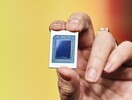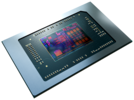AMD Ryzen 5 6600H vs AMD Ryzen 7 7840S vs AMD Ryzen 5 7640HS
AMD Ryzen 5 6600H
► remove from comparison
The AMD Ryzen 5 6600H is a processor for big (gaming) laptops based of the Rembrandt generation. The R5 6600H integrates six of the eight cores based on the Zen 3+ microarchitecture. They are clocked at 3.3 (guaranteed base clock) to 4.5 GHz (Turbo) and support SMT / Hyperthreading (12 threads). The chip is manufactured on the modern 6 nm TSMC process.
The new Zen 3+ is a refresh of the Zen 3 architecture and should not offer a lot of changes. The chip itself however, offers a lot of new features, like support for USB 4 (40 Gbps), PCI-E Gen 4, DDR5-4800MT/s or LPDDR5-6400MT/s, WiFi 6E, Bluetooth LE 5.2, DisplayPort 2, and AV1 decode.
In the 6000 series, AMD finally switched to the current RDNA 2 graphics architecture for the iGPU. The 6600H only offers the slower Radeon 660M with 6 of the 12 CUs enabled and 1.9 GHz max. clock speed.
Performance
The average 6600H in our database is in the same league as the R7 5825U, the R7 6800U and also the Core i5-1340P, as far as multi-thread benchmark scores are concerned. This is a very decent result, as of late 2022.
Your mileage may vary depending on how high the CPU power limits are, and how competent the cooling solution of your system is.
Power consumption
This Ryzen 5 series APU has a default TDP, also known as the long-term power limit, of 45 W. A high-performance cooling solution is a must for a system built around such a chip.
The R5 6600H is built with TSMC's 6 nm process for great, as of early 2023, energy efficiency.
AMD Ryzen 7 7840S
► remove from comparison
The AMD Ryzen 7 7840S is a fast high-end laptop processor of the Phoenix series. It offers 8 cores (octa core) based on the Zen 4 architecture that supports hyperthreading (16 threads). The cores clock from 3.8 (base) up to 5.1 GHz (single core boost). The processor includes 8 MB L2 cache and 16 MB L3 cache. The processor is exclusively available in Lenovo laptops but the specs are similar to the regular Ryzen 7 7840HS.
The performance of the R7 7840S is only slightly below the fastest model, the R9 7940HS, as the clock speed difference is only minimal (e.g. -100 MHz / 2% slower single core boost). Therefore, the CPU should also perform slightly higher than the old top model Ryzen 9 6980HX (8 Zen 3 cores with up to 4.9 GHz) at 54W TDP and Ryzen 9 6980HS at 35W TDP. Compared to the higher end Dragon Range series, the 7840HS should be similar to the Ryzen 7 7745HX (also 8 Zen 4 cores, max 5.1 GHz, 55W TDP, 32 MB L3).
The chip integrates a modern and fasts RDNA 3 graphics card (iGPU) called Radeon 780M with 12 CUs and up to 2.7 GHz clock speed. Furthermore, the Phoenix series include a video engine with AV1 de- and encoding, a new Xilinx FPGA based XDNA AI accelerator (Ryzen AI) that should be faster than the AI engine in the Apple M2 SOC and a dual-channel DDR5-5600 / LPDDR5x-7500 memory controller (with ECC support). The connectivity features includes 2 possible USB 4 (40 Gbps) ports and 20 PCIe 4.0 lanes for a GPU and SSDs.
The Phoenix series uses a single monolithic design (unlike the chiplet design of the 7045HX series) and is manufactured in the modern 4nm process at TSMC. The TDP can be configured between 35 and 45 Watt.
AMD Ryzen 5 7640HS
► remove from comparison
The Ryzen 5 7640HS is an upper mid-range processor (APU) of the Phoenix product family. It was brought to life in H1 2023 and it has 6 SMT-enabled Zen 4 cores (12 threads) running at 4.3 GHz to 5.0 GHz. The laptop chip is one of the first to feature Ryzen AI, AMD's answer to Intel's DL Boost and GNA technologies. The Radeon 760M iGPU is responsible for carrying out 3D calculations and similar duties.
Architecture & Features
Phoenix family chips are powered by the Zen 4 architecture, much like Dragon Range family chips are. The latter however lacks hardware AI workload acceleration capabilities that Phoenix has.
More importantly, Zen 4 introduces AVX512 support (Zen 3-powered chips did not have that) and, thanks to a plethora of other improvements including larger caches/registers/buffers across the board, is set to bring a double-digit IPC improvement.
Elsewhere, the 7640HS has 16 MB of L3 cache and a super-fast DDR5-5600 / LPDDR5x-7500 RAM controller. USB 4 (and thus Thunderbolt) is supported natively and so is PCIe 4. In fact, 20 PCIe 4 lanes are on offer; data transfer speeds of up to 7.8 GB/s will be possible provided a sufficiently fast NVMe SSD is used.
Systems powered by this Ryzen 5 series chip are expected to run 64-bit Windows 11, 64-bit Windows 10, or Linux. Please note that the APU is not overclockable and neither will you be able to replace it with a faster one as it gets soldered down permanently (FP7, FP7r2, FP8 socket interfaces).
Performance
The average 7640HS in our database is about as fast as the Ryzen 9 5900HX, Ryzen 7 6800H, Ryzen 7 7736U and also the Core i5-12500H, as far as multi-thread benchmark scores are concerned. This is a good if not record-breaking result as of mid 2023. Such a CPU will handle pretty much any task you can throw at it, gaming included.
Your mileage may vary depending on how high the CPU power limits are and how competent the cooling solution of your system is.
Graphics
The Radeon 760M has 8 CUs (512 shaders) running at up to 2,600 MHz. While this is not the best graphics adapter for gaming as it's only just fast enough for low quality settings and resolutions such as 1600 x 900, it will let you connect up to four SUHD 4320p monitors and it also HW-encodes and HW-decodes the most widely used video codecs such as AV1, HEVC and AVC.
Power consumption
The 7640HS has a long-term power limit (default TDP) of 35 W to 54 W, giving laptop makers a choice between improving battery life and giving the system they are working on more oomph. Either way, an active cooling solution is a must for any system powered by this chip.
The APU is built with TSMC's 4 nm process for high, as of late 2023, energy efficiency.
| Model | AMD Ryzen 5 6600H | AMD Ryzen 7 7840S | AMD Ryzen 5 7640HS | ||||||||||||||||||||||||||||||||||||||||||||||||||||||||||||||||||||
| Codename | Rembrandt-H (Zen 3+) | Phoenix-HS (Zen 4) | Phoenix-HS (Zen 4) | ||||||||||||||||||||||||||||||||||||||||||||||||||||||||||||||||||||
| Series | AMD Rembrandt (Zen 3+) | AMD Phoenix (Zen 4) | AMD Phoenix (Zen 4) | ||||||||||||||||||||||||||||||||||||||||||||||||||||||||||||||||||||
| Series: Phoenix (Zen 4) Phoenix-HS (Zen 4) |
|
|
| ||||||||||||||||||||||||||||||||||||||||||||||||||||||||||||||||||||
| Clock | 3300 - 4500 MHz | 3800 - 5100 MHz | 4300 - 5000 MHz | ||||||||||||||||||||||||||||||||||||||||||||||||||||||||||||||||||||
| L1 Cache | 384 KB | 512 KB | 384 KB | ||||||||||||||||||||||||||||||||||||||||||||||||||||||||||||||||||||
| L2 Cache | 3 MB | 8 MB | 6 MB | ||||||||||||||||||||||||||||||||||||||||||||||||||||||||||||||||||||
| L3 Cache | 16 MB | 16 MB | 16 MB | ||||||||||||||||||||||||||||||||||||||||||||||||||||||||||||||||||||
| Cores / Threads | 6 / 12 | 8 / 16 | 6 / 12 | ||||||||||||||||||||||||||||||||||||||||||||||||||||||||||||||||||||
| TDP | 45 Watt | 35 Watt | 45 Watt | ||||||||||||||||||||||||||||||||||||||||||||||||||||||||||||||||||||
| Technology | 6 nm | 4 nm | 4 nm | ||||||||||||||||||||||||||||||||||||||||||||||||||||||||||||||||||||
| max. Temp. | 95 °C | 100 °C | 100 °C | ||||||||||||||||||||||||||||||||||||||||||||||||||||||||||||||||||||
| Socket | FP7/FP7r2 | FP7/FP7r2/FP8 | FP7/FP7r2/FP8 | ||||||||||||||||||||||||||||||||||||||||||||||||||||||||||||||||||||
| Features | DDR5-4800/LPDDR5-6400 RAM (incl. ECC), PCIe 4, MMX, SSE, SSE2, SSE3, SSSE3, SSE4A, SSE4.1, SSE4.2, AVX, AVX2, BMI2, ABM, FMA, ADX, SMEP, SMAP, SMT, CPB, AES-NI, RDRAND, RDSEED, SHA, SME | DDR5-5600/LPDDR5x-7500 RAM (incl. ECC), PCIe 4, Ryzen AI, MMX, SSE, SSE2, SSE3, SSSE3, SSE4A, SSE4.1, SSE4.2, AVX, AVX2, AVX-512, BMI2, ABM, FMA, ADX, SMEP, SMAP, SMT, CPB, AES-NI, RDRAND, RDSEED, SHA, SME | DDR5-5600/LPDDR5x-7500 RAM, PCIe 4, Ryzen AI, AES, AVX, AVX2, AVX512, FMA3, MMX (+), SHA, SSE, SSE2, SSE3, SSE4.1, SSE4.2, SSE4A, SSSE3 | ||||||||||||||||||||||||||||||||||||||||||||||||||||||||||||||||||||
| iGPU | AMD Radeon 660M ( - 1900 MHz) | AMD Radeon 780M ( - 2700 MHz) | AMD Radeon 760M ( - 2600 MHz) | ||||||||||||||||||||||||||||||||||||||||||||||||||||||||||||||||||||
| Architecture | x86 | x86 | x86 | ||||||||||||||||||||||||||||||||||||||||||||||||||||||||||||||||||||
| Announced | |||||||||||||||||||||||||||||||||||||||||||||||||||||||||||||||||||||||
| Manufacturer | www.amd.com | www.amd.com | www.amd.com | ||||||||||||||||||||||||||||||||||||||||||||||||||||||||||||||||||||
| Die Size | 178 mm2 | 178 mm2 |
Benchmarks
Average Benchmarks AMD Ryzen 5 6600H → 100% n=22
Average Benchmarks AMD Ryzen 7 7840S → 130% n=22
Average Benchmarks AMD Ryzen 5 7640HS → 120% n=22
* Smaller numbers mean a higher performance
1 This benchmark is not used for the average calculation












